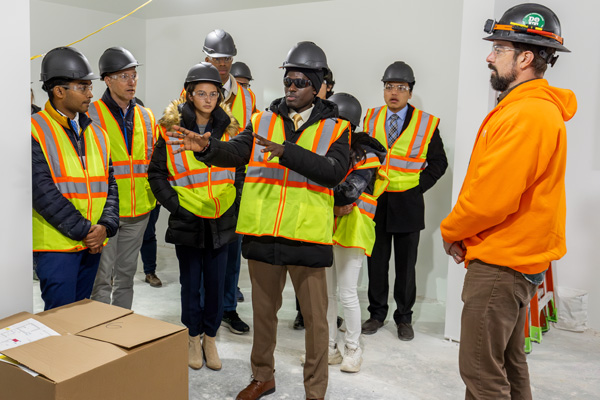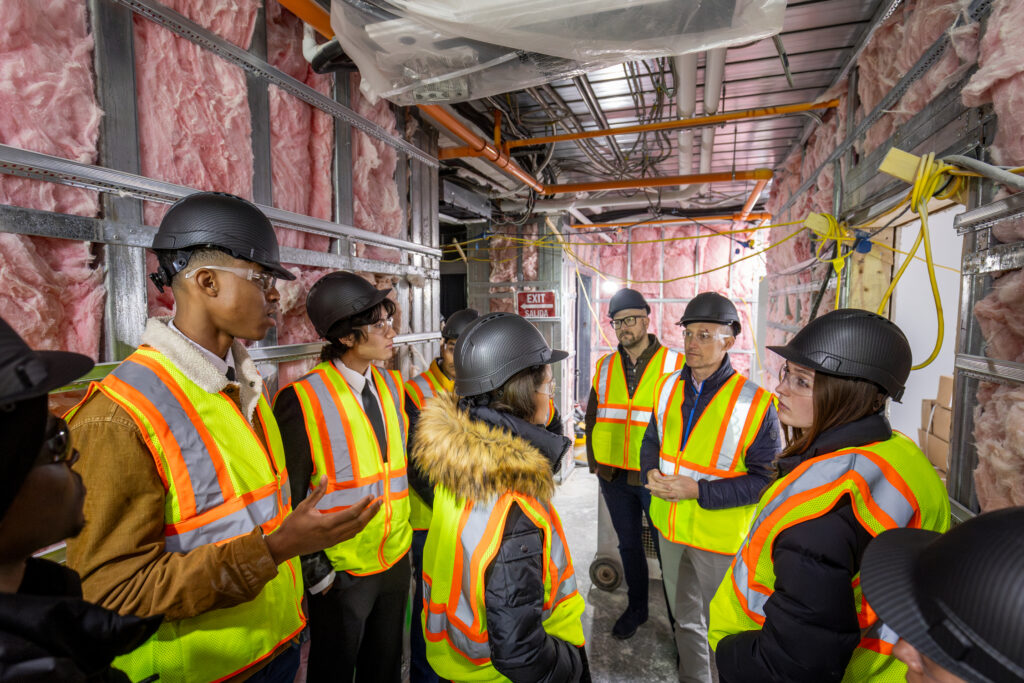Students learn about financing affordable housing developments

Dyson School student Joseph Gicharu asks Corey Olmstead, of Vecino Group, a question (photo by Simon Wheeler).
Eight SC Johnson College undergraduates visited an active construction site in downtown Ithaca, NY, in early November to learn about financing affordable housing developments. The tour was part of a course taught by professor of practice Trent Preszler that introduces students in the Charles H. Dyson School of Applied Economics and Management to its Grand Challenges program and the ways in which businesses can support the United Nations Sustainable Development Goals.
“When people think about affordable housing, they don’t think about the beautiful apartments that we were able to tour,” said Baldo Granados ’25, who was a licensed real estate agent in Austin, TX, before transferring to Cornell. “I’m very familiar with the whole process for residential real estate, so seeing a commercial development was really cool.”

Students first participated in a classroom discussion and lecture about affordable housing with guest Brad Howarth, managing director of the affordable housing investment company CREA, LLC. Then, they toured the Asteri Ithaca Residences with Howarth and Corey Olmstead, a senior project manager at Vecino Group, the developer for the site. CREA, LLC serves as the tax credit syndicator for this development, connecting the investor with the property, facilitating the transfer of funds to the property and tax credits to the investor, and managing the investment on behalf of the investor for the 15-year compliance period.
Granados said he previously only had a basic understanding of the federal government’s Low Income Housing Tax Credit Program (LIHTC). “I just didn’t know how the market was built,” Granados said. “[Howarth’s] explanation of the partnership between the public and private sectors was super interesting and something I had never wrapped my brain around before.”
Once complete, the $62 million residential development will include 181 apartments available to people earning between 30 and 80 percent of the area median income (AMI). Forty units are designated for people who have experienced recent or chronic homelessness, and these residents will receive rental assistance from a state program, in addition to on-site support with financial literacy, job preparation, and other life skills. All residents will have access to common amenities including a rooftop terrace, a fitness center, a community room, laundry facilities, and indoor bike storage.
“I hope that students challenge any preconceived ideas about what affordable housing is and can be,” Howarth said, adding that he was impressed with the students’ deep thoughtfulness regarding housing issues. “And I hope they begin to understand the urgency of the affordable housing crisis we’re facing in the U.S. with a shortage of over 7 million homes for extremely low-income households.”
Through the semester-long course, called “Design Your Dyson,” all first-year and transfer students learn about a wide array of perspectives in business, said Preszler, who co-teaches the class with David Lennox, senior lecturer, and Andrea Poag, director of advising and student services at the Dyson School. This semester has included guest lecturers from the New York City Mayor’s Office of Food Policy; the International Center for Research on Women; Jordan Energy; Goldman Sachs; and MSNBC.

“I chose guest speakers who have leveraged their leadership roles in business to address society’s most intractable problems in unusually creative ways,” Preszler said. “How do we address the affordable housing crisis? There is no silver bullet, but it can’t be done without businesses being fully engaged. By providing opportunities for students to interact directly with inspiring business leaders, we’re challenging students to think more broadly about their own futures.”
